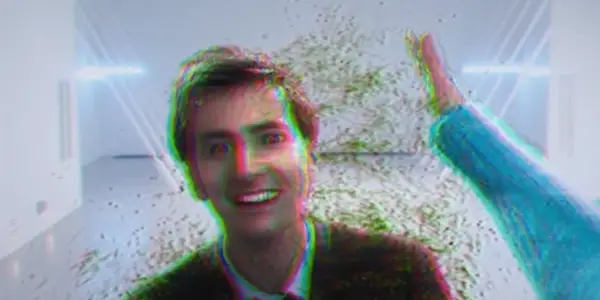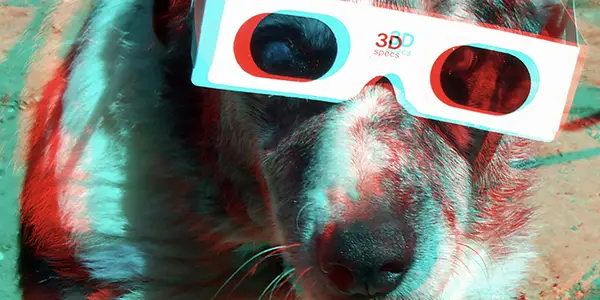Fantasy Science Pt. 17: The 3D Glasses Of DOCTOR WHO

Radha has a PhD in theoretical quantum physics. Apart from…
EM Waves. Polarization. 3D. Have you heard terms like these flying around the science fiction sections of the film/tv world? Have you ever wondered just how accurately these films portray real science? Well, my friends, today is your lucky day: this column, Fantasy Science & Coffee, aims to bridge the gap between science and science fiction in films and popular culture. My hope is to explain things in a fun way – like we’re chatting over coffee.
You may be thinking: who is this person, why does she think she can explain science, and why the heck would I want to have coffee with her? Well, I’m Radha, a researcher in India, currently pursuing a PhD in theoretical quantum physics. I quite like hot beverages. I’ll also pay.

In this seventeenth part of the series published on the second and fourth Tuesdays of every month, we are going to look at the Tenth Doctor’s iconic 3D glasses. Let’s begin.
The Tenth Doctor’s 3D Glasses
The Doctor Who universe is full of symbolic items, from extraordinarily long striped scarves to gas masks to bow ties. One such item of note is the Tenth Doctor’s red and blue 3D glasses. They appear to be ordinary anaglyph glasses, but rather than using them to watch 3D films, the Doctor wears them to observe void stuff.
In the twelfth and thirteenth episodes of Series 2, an object is spotted at Torchwood that appears to exist outside of time and space. It is later revealed to be a void ship, or a ship created to stay in the void — the space in between parallel universes that are stacked up against each other. The ship, full of Daleks, traveled through a space-time breach to our universe, creating cracks through which Cybermen from a parallel universe arrived.

Anyone who passes through the void trails along what the Doctor calls void stuff, which appears as little speckles that can be seen only with the help of anaglyph glasses. Take a look at this snippet from Doomsday, Episode 13 of Series 2:
DOCTOR: Well? Isn’t anyone going to ask what is it with the glasses?
ROSE: What is it with the glasses?
DOCTOR: I can see, that’s what. Because we’ve got two separate worlds, but in between the two separate worlds, we’ve got the Void. That’s where the Daleks were hiding. And the Cybermen travelled through the Void to get here. And you lot, one world to another, via the Void. Oh, I like that. Via the Void. Look.
(He gives the spectacles to Rose.)
DOCTOR: I’ve been through it. Do you see?
(Lots of speckles in the air around the Doctor.)
ROSE: What is it?
DOCTOR: Void stuff.
ROSE: Like er, background radiation.
DOCTOR: That’s it.
The question is, why can void stuff only be seen with the Doctor’s glasses? I believe the answer lies in how the glasses work.
How 3D Glasses Work
All 3D glasses work on the same basic principle: each eye receives a different, slightly offset 2D image. When the images are combined, the brain creates the perception of depth and distance on screen.

For the classic anaglyph glasses, the red and blue (or, more accurately, cyan) act as color filters. Take a look at this adorable dog. Each of the two offset images in this single image has two different colors, making the dog look a little blurry though not any less adorable. If you put on a pair of anaglyph glasses, each of the two images will be seen clearly through one of the filters. This is because each color has a unique wavelength. The color filters allow the wavelengths of their own colors to pass while blocking other wavelengths. The red filter blocks the blue image, allowing only the red image to pass.
Unfortunately, as nifty as they look, anaglyph glasses tend to affect the color quality of images. As a result, 3D glasses today mostly use polarizing lenses. Each lens in a pair of these 3D glasses has a different direction of polarization. For a 3D film, two synchronous projections with different polarizations are projected onto the screen. Each of the projections can be viewed through one of the lenses.
You see, a light wave is an electromagnetic (EM) wave, which is actually a superposition of many waves, all with differently varying electric field vectors. (For a deeper understanding of electromagnetism, check out part 15.) A polarizer only allows EM waves to pass for which the electric field vector matches its direction of polarization. It’s sort of like the sieve you use when you separate leaves from water when making tea.
To make it easier to visualize, here’s a short and sweet Scientific American video demonstrating how anaglyph and polarized 3D glasses work:
The only thing I completely disagree with is the comment that polarizing glasses look “way cooler than the colorful cardboard glasses”. I’d call the red and blue cooler any day, but that’s probably just the Whovian in me talking.
Let’s turn back to the pressing question of the hour: why did using anaglyph glasses allow the Doctor to see void stuff? I believe the void particles are slightly offset themselves, similar to 3D content having two offset images. The only difference is that we can still see 3D content with the naked eye, even if it isn’t sharp, whereas void stuff is invisible to the naked eye. If we remember that in Doctor Who, void stuff is essentially the residue of something that exists outside of time and space, it might make sense that the speckles are in slightly two different places at once, and different colors at that. I suppose you’d have to ask the Doctor to know for sure.
What do you think?
More to Explore
Articles
LiveScience: Taking An In-Depth Look at 3-D Glasses (2010)
Resources
How Stuff Works: Why aren’t 3-D glasses red and blue anymore?
How Stuff Works: How 3-D Glasses Work
The Physics Classroom: Polarization
Lumen Physics: Polarization
Khan Academy: Polarization of light, linear and circular
Vision Doctor: Color Filters
Olympus: Light Filtration
Does content like this matter to you?
Become a Member and support film journalism. Unlock access to all of Film Inquiry`s great articles. Join a community of like-minded readers who are passionate about cinema - get access to our private members Network, give back to independent filmmakers, and more.
Radha has a PhD in theoretical quantum physics. Apart from research, she consults on sci-fi screenplays/books. In her free time, she cosplays and irritates her three cats. Bug her on Twitter: @RadhaPyari













